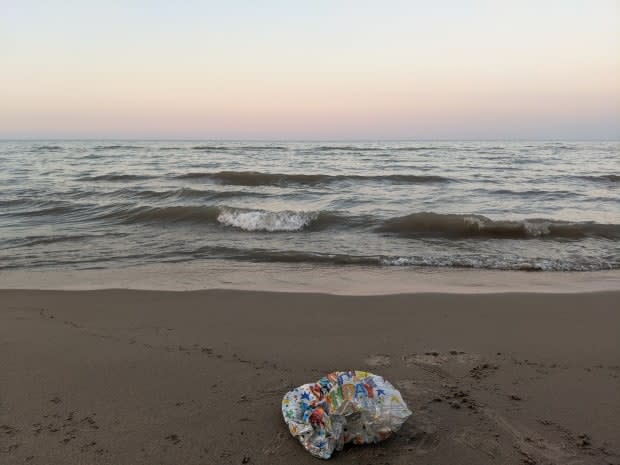Biologist estimates helium balloons are ending up in Great Lakes by the hundreds of thousands

The plastic balloons we use to mark some of the biggest milestones in our lives — births, deaths, graduations, homecomings, engagements, gender reveal parties — are ending up in the Great Lakes by the hundreds of thousands, according to an Ontario biologist who spent two weeks gathering trash.
Leanne Grieves is a postdoctoral fellow at McMaster University in Hamilton who studies bird behaviour and communication. This summer, she's been working at Birds Canada at Long Point on the north shore of Lake Erie.
"Lake Erie is beautiful and the shoreline is just stunning, especially if you're on the Long Point peninsula," she said. "It's really a glorious place to be."
What wasn't so glorious, though, was the trash, which became such an eyesore for Grieves that she couldn't help herself.
Hundreds of balloons along 7 km of beach
"There is just so much garbage washing up on shore," she said. "After a couple of days driving up and down to our site, I just thought, 'This is ridiculous. We have to start cleaning this up.'"

So Grieves and fellow biologist Ryan Ley started going up and down the shore, picking up whatever trash they found. In just under two weeks, across seven kilometres of beach, the pair amassed less than 380 helium balloons — and it wasn't always easy.

"Sometimes I had to wade out in my rubber boots to get balloons that hadn't yet washed ashore," Grieves said.
"Sometimes it would involve digging into the sand to extract balloons that had been buried and sometimes going up into the surrounding habitat to extract balloons from trees and shrubs."
The mass release of balloons has been a traditional way to celebrate special events for decades, but the practice is becoming increasingly controversial as studies highlight the environmental consequences.
While the balloons do break down over time, they don't dissolve completely, and the smaller plastic debris ends up in the environment, where animals can mistake it for food.
When ingested, the plastic provides no nutritional value and if the pieces are large enough, they can block or become lodged in the intestinal tracts of animals, slowly starving them to death.
Animals, such as birds and turtles, can also become ensnared in the strings and streamers that accompany balloons, drowning them or weighing them down so much that they're unable to find food.
The Canadian Wildlife Federation suggests alternatives to releasing balloons, such as planting a tree or memorial garden, to honour a loved one.
On its website, the federation notes that balloons can travel long distances when carried by winds and currents, noting a report about a balloon released at the 1998 Winter Olympics in Nagano, Japan, that ended up in Los Angeles 8,500 kilometres away.
Shiny, metallic-looking mylar balloons, in particular, have been known to cause fires or blackouts when they become entangled in power lines.
Gender reveal, grad balloons common finds
Despite the dangers, people are still releasing plenty of balloons.
Grieves said she and Ley found plenty of pink and blue balloons released at trendy gender reveal parties, as well as graduation balloons coinciding with the end of the school year.

"They say things like 'follow your dreams' or 'the adventure is just beginning,' but it's just this huge balloon trashing this beautiful landscape, so it's a bit shocking to see that."
One of the most striking finds that illustrates how a seemingly small and fleeting moment of celebration can have a lasting effect on the environment, according to Grieves, was a balloon from last Christmas.
"It was dated December 13, 2020 and it was in quite good shape, so these balloons really do stick around in the environment for months, if not, years."
During her trash-finding work, Grieves documented everything, including taking took pictures of each one before stuffing it into a trash bag and carefully noted the amount collected and where.
She also did a little math. Once she and Ley cleaned a section of beach, they returned the next day and counted every new balloon they found along that same stretch.
Based on her calculations, she estimates 1.9 balloons wash up on every kilometre of Lake Erie's 1,400-km shoreline each day.
The potential impact is 'staggering'
"If you assume they wash up on the Lake Erie shoreline at an equal rate, it's possible that 960,000 balloons wash up on the Lake Erie shoreline every year," she said.

"Even if my estimate is off by 50 per cent, that's half a million balloons that are washing up just on one of our Great Lakes. The potential impact of these balloons is staggering."
She said given the sheer number of balloons Grieves found that seemed to cover the gamut, from Mother's Day to welcoming the troops home, it shows how popular the practice of releasing balloons into the air is, despite the environmental consequences.
With the exception of a few Ontario communities passing their own bylaws banning the release of large numbers of helium balloons, there is no provincial or federal legislation regulating the practice.
A New Democrat-sponsored petition to the House of Commons is trying to gain enough signatures to ban the release of helium balloons, along with sky lanterns, making it punishable by levying a fine.
Grieves hopes by sharing her work, more people will understand the potential environmental consequences of releasing helium balloons.
"Balloon releases are an ongoing issue and you can't just clean them up once, and we'll continue to clean them until we stop releasing them."

 Yahoo Finance
Yahoo Finance 